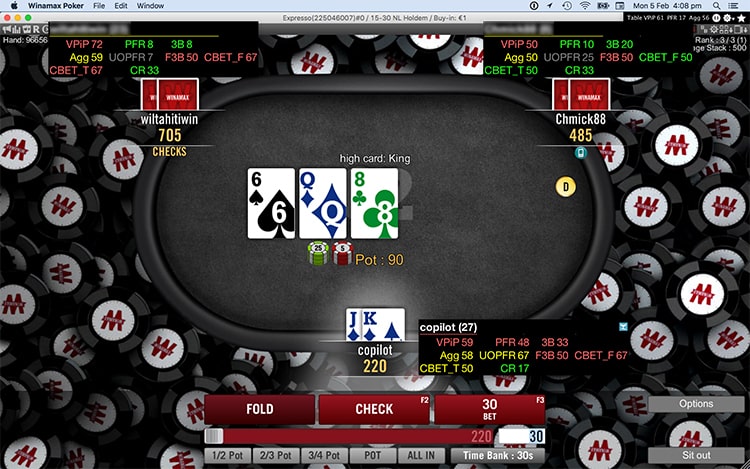Essential No Limit Holdem Strategy: The Three-bet
Welcome to Poker Copilot’s Essential Strategy series, where we take a look at tactics, techniques, and concepts you’ll need to understand if you want to become a winning poker player.
Today’s post is about the preflop reraise, also referred to as the three-bet.
It is called a three-bet because it is essentially the third bet made after the cards are dealt – the first being the blinds, and the second being the opening bet. Incidentally, this terminology also extends to subsequent bets, with another raise often referred to as a four-bet, and so forth.
It’s important for novice players to note that we are not discussing play once the flop has been seen. Re-raising post-flop has additional considerations, such as your opponents’ pre-flop betting and the flop cards. We’ll get into this in another article.
In this piece we will discuss the player’s reasons for making a three-bet, the cards you should be three-betting with, and how the reads you have on your opponents should factor into your decision to fire one off.
Why Make a Three-bet
There are five reasons why you would consider showing this amount of aggression pre-flop:
Get Value With Your Premium Hands
In most cases, there are two hands you should comfortably go all-in with pre-flop: AA and KK. While your cowboys will occasionally get called by pocket aces, they will also get called by QQ and AJs often enough to make it a profitable play. When you’re trying to encourage this level of action pre-flop, a three-bet is essential to get the ball rolling.
Get Information on Your Opponents
One of the most effective ways to get additional information on your opponent’s hand is to make a three-bet. If you’re holding strong cards like QQ-TT, AK-AT, KQs, etc that are still dependent on a kind flop, seeing your opponent’s response to a three-bet often gives you vital information on how you should play post-flop. Three-betting gives your opponent – who is holding AA – a chance to four-bet or shove. This is extremely valuable information if you’re holding JJ.
Isolate Your Opponent
Medium strength hands like AQ KQs play well against a solitary opponent. Seeing the flop with ATo against two players is not ideal so a three-bet is vital if you want one of your opponents to lay down a marginal hand.
Push Back Against Steals
Sometimes you are going to have to protect your blinds and challenge a player who you suspect is taking advantage of their position with marginal cards. This is very dependent on a read you have on your opponent and should also not be done without taking your cards into consideration at all.
Avoid Predictability
As the quality of your opponents increases and their reads on you become increasingly accurate, it becomes extremely important to give as little information away as possible. When all you do pre-flop is call or raise, your opponents will quickly get a solid idea of your pre-flop ranges. By adding a third play to your arsenal, you are making it difficult to predict what you could be holding. This becomes more applicable if you open your three-betting range up as your position improves.
Three-bet Sizing
We’ve touched on this topic before and this won’t be the last time we’re discussing it either. A common mistake novice players make is to size their bets proportionate to the confidence they have in their hands. This is a leak that regulars at your table will take advantage of.
This doesn’t mean, however, that your three-bet sizing should always be consistent. Except, instead of basing the size on the quality of your cards, base it on your position.
The risk you’re facing with making a specific play is always either mitigated by having position on your opponents or compounded by them having position on you. What does this mean for three-bet sizing?
It means that if you’re in a poor position pre-flop and several players need to act after you have made your bet, you need to make them pay a premium to stay in the hand. That’s why a strong raise of 4 times the original raise is advisable.
Conversely, if you are on the button, you can benefit from the advantage you’re going to have once the flop is seen and limit your three-bet to three times the original raise.
Three-bet Range
There are two types of hand ranges that a good poker player will apply, depending on the context of the hand or the table dynamics. Acknowledging these two ranges and knowing when to switch between them is a very valuable skill for a new player to learn.
Never play either one or the other. It may be comforting to choose which one of these best fits your style of play, but that concept in itself is damaging your profit. You do not want a style of play. You want to hide how you play as much as possible, and switching between these two approaches is an extremely effective way of doing so.
Polarized range
A player playing with a polarized range is three-betting with either the absolute premium hands like AA and KK or they are bluffing.
When to play with a polarized range should be relatively obvious. You want to win big with your premium hand, or you have a read on a player that is exploiting his position to steal the blinds.
Merged Range
This range includes the premium hands mentioned above and also strong hands like AK-AT, KQ-KTs, QQ-77.
You are playing with a merged range because you are comfortable to see the flop and want to get an idea of what your opponent might be holding. Playing with a merged range also often results in the original raiser folding to your three-bet. This is why making this play with a hand like ATo is sometimes called a “semi-bluff”.
Unsurprisingly, position is crucial in choosing a merged range. When you are going to be first to act after the flop, you are better off playing with a polarized range since you are at a disadvantage and don’t want to be in a tricky spot out of position holding medium strength cards.
Getting a Read
Pay attention to your opponents’ responses when they are faced with a three-bet. What you are looking for are indications of the cards that a player calls a three-bet with. A hand that goes to showdown when there was some interesting pre-flop action is invaluable to the savvy poker player. Remember how the hand played out and see what your opponents were holding. This applies not only to the ranges that they three-bet with but also what they were holding when calling one of yours.
An additional, highly recommended, approach is to install a head-up display (HUD) like Poker Copilot. A HUD is a piece of software that keeps track of every single hand that you have ever played online, parses the outcomes of these hands, and presents predefined information on your opponents. This data is displayed in a visual layer which overlays your online poker table.
As you might expect, this data is extremely helpful in making decisions on how to proceed with a particular hand, since a massive amount of data on your opponent’s playing style is at your fingertips. See the screenshot below for an illustration of how this works.

The data points dealing with your opponents’ three-bet tendencies are: Three-bet Pre-flop (3B) and Folded to Three-bet Pre-flop (F3B).
The F3B statistic is especially helpful if you are playing with a polarized range and attempting to get your opponent to fold. Ideally, you should only attempt this bluff if this statistic indicates that you have seen the player fold to a three-bet.
The 3B statistic is most helpful when you are attempting to put your opponent on a hand range after they fire off a three-bet. See the Facing a Three-bet section below for more information on how to interpret this statistic.
Facing a Three-bet
Knowing how to respond to a three-bet is as critical to becoming a successful player as knowing when to make one yourself. As you progress up the stake-levels, you are going to encounter them more and more frequently as your pre-flop bets are given little of the respect they got at the lower end of the micro-stakes.
Being successful against three-bets comes down to understanding your opponent. It really is that simple. Install a HUD and keep meticulous notes on your opponents because having a grasp of their three-bet range is paramount to respecting or exploiting their plays.
Decent players maintain a 3B value between 6%-9%. This represents a range that is very difficult to predict. However, if you face a three-bet from a player with a 3B value of 1%, you can be relatively confident they are holding a premium hand like AA or KK.
Position is absolutely critical to bear in mind here – so much that many experts urge novice to intermediate players simply never to call a three-bet against such an opponent unless they have position on them.
Always bear in mind whether you or he will act first after the flop. Having a view of their continuation-bet statistic is also important when making a decision to call in this spot. Expect further aggression from this player when you make the call.
When you do have position, it’s also important to remember that your opponent also knows you have position on them. As an extension of the logic mentioned in the Three-bet Sizing section above, this is very likely to indicate remarkable strength on their part since they are unlikely to three-bet out of position with a poor hand.
When making the call, always base your post-flop decisions on a constant mental “view” of their three-bet range. If whatever hand you’ve made on the flop is good against a good portion of that range, position allows you to comfortably control the pot down to showdown.
Conclusion
For new players who may not fully understand the advantages of showing aggression and struggle with the risk inherent to building big pots, three-betting can be a daunting proposition. However, it is a crucial weapon to have in your arsenal of strategies as you progress up the online poker ranks.
Remember the reasons why you’re three-betting. Never make a pre-flop reraise if you aren’t sure what you’re trying to achieve with it.
Install and actively use a HUD to maintain data on your opponent’s’ three-betting habits. These tools are crucial when you’re new to a specific strategy where basing decisions on hard data is more effective than a ‘read’ you have of a specific player.
See you at the tables!
